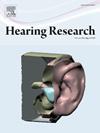人工耳蜗使用者耳蜗内电场分布的研究及其与语音感知的关系
IF 2.5
2区 医学
Q1 AUDIOLOGY & SPEECH-LANGUAGE PATHOLOGY
引用次数: 0
摘要
背景:在人工耳蜗(CIs)的研究中,客观测量及其与听力表现的关系是一个重要的研究方向。励磁扩展(SoE)和电压矩阵(VM)都是电场扩展的客观描述。VM更容易度量,因此优于SoE。本研究的目的是比较术后两种测量结果,并调查它们与听力表现的关系。方法将17例ci患者中10例术后SoE和VM数据归一化至比较前最大振幅。先前发表的基于soe宽度的分析方法(Rader et al., 2023)被改编并应用于VM数据。ECAP分离指数(来自Hughes, 2008)比较两个相邻电极的SoE数据,也适用于17个ci用户的VM数据,并与语音感知相关。结果在大多数ci用户中,记录的SoE和VM数据相关性强。标准化的SoE和VM数据显示出良好的一致性。一些偏差是可以观察到的:SoE和VM数据的平均均方根差为0.159。从指数拟合中提取的不对称宽度度量在SoE和VM数据之间存在显著差异。宽度测量与语音感知之间没有相关性。虚拟机分离指数与语音感知相关。结论soe和VM是密切相关的指标,但两者并不完全相同。SoE中的神经信息不能被忽略,VM不能代替SoE。VM分离指数似乎是预测听力表现的一种很有前途的方法。然而,需要进一步的研究来证实这一发现。本文章由计算机程序翻译,如有差异,请以英文原文为准。
Investigation of intracochlear electrical fields with spread of excitation and voltage matrix in cochlear implant users and their link to speech perception
Background
Objective measures and their relation to listening performance are of interest in the study of cochlear implants (CIs). Both spread of excitation (SoE) and the voltage matrix (VM) are objective descriptors of electric field spread. VM is easier to measure and therefore preferable to SoE. The aim of the study was comparing both measurements postoperatively and investigating their relation to listening performance.
Methods
Postoperative SoE and VM data for 10 out of 17 CI-users were normalized to their maximum amplitude before comparison. A previously published SoE-width-based analysis method (Rader et al., 2023) was adapted and applied to the VM data. The ECAP separation index (from Hughes, 2008), comparing SoE data of two neighboring electrodes, was also adapted to the VM data of 17 CI-users and correlated with speech perception.
Results
Recorded SoE and VM data correlated strongly in most CI-users. The normalized SoE and VM data showed good alignment. Some deviations were observable: an average RMS-difference of 0.159 normalized amplitude was found between SoE and VM data. Asymmetric width measures extracted from exponential fitting differed significantly between SoE and VM data. No correlation between width measures and speech perception could be found. The VM separation index correlated with speech perception.
Conclusions
SoE and VM are closely related measurements, however they are not identical. The neural information in SoE can’t be ignored and VM can’t replace SoE. The VM separation index appeared to be a promising approach for predicting listening performance. Nevertheless, further research is required to corroborate this finding.
求助全文
通过发布文献求助,成功后即可免费获取论文全文。
去求助
来源期刊

Hearing Research
医学-耳鼻喉科学
CiteScore
5.30
自引率
14.30%
发文量
163
审稿时长
75 days
期刊介绍:
The aim of the journal is to provide a forum for papers concerned with basic peripheral and central auditory mechanisms. Emphasis is on experimental and clinical studies, but theoretical and methodological papers will also be considered. The journal publishes original research papers, review and mini- review articles, rapid communications, method/protocol and perspective articles.
Papers submitted should deal with auditory anatomy, physiology, psychophysics, imaging, modeling and behavioural studies in animals and humans, as well as hearing aids and cochlear implants. Papers dealing with the vestibular system are also considered for publication. Papers on comparative aspects of hearing and on effects of drugs and environmental contaminants on hearing function will also be considered. Clinical papers will be accepted when they contribute to the understanding of normal and pathological hearing functions.
 求助内容:
求助内容: 应助结果提醒方式:
应助结果提醒方式:


